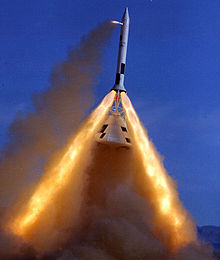Launch escape system


A Launch Escape System (LES) is a top-mounted rocket connected to the crew module of a crewed spacecraft and used to quickly separate the crew module from the rest of the rocket in case of emergency. Since the escape rockets are above the crew module, an LES typically uses separate nozzles which are angled away from the crew module to prevent the LES exhaust from striking the module, cutting through the hull, and immolating the crew. The LES is designed for use in situations where there is an imminent threat to the crew, such as an impending explosion.
Uses
Historically, LESes were used on American Mercury and Apollo spacecraft. They continue to be used on the Russian Soyuz spacecraft and will be used on the private spaceflight company Excalibur Almaz's spacecraft as well as the Orion spacecraft currently under development by the United States government.
The LES may be used while the launch vehicle is still on the launch pad, or during its ascent.
Related systems
The Russian Vostok and American Gemini spacecraft both made use of ejection seats. The European Space Agency's Hermes and the Russian Buran space shuttles would also have made use of them if they had ever flown with crews. As shown by Soyuz T-10a, an LES must be able to carry a crew compartment from the launch pad to a height sufficient for its parachutes to open. Consequently, they must make use of large, powerful (and heavy) solid rockets. If possible, spacecraft designers prefer to use ejection seats as they are lighter and would be available for use when the spacecraft is returning to Earth. However, ejection seats are generally considered impractical for spacecraft with large crews, as separate seats and likely separate exit hatches would have to be provided for each crew member.
The Space Shuttle was initially fitted with ejection seats for the initial "shakedown" flights, but these were removed once the vehicle was deemed operational. Following the Challenger disaster, all surviving orbiters were fitted to allow for crew evacuation through the main hatch, though this can only be used when the shuttle is in a controlled glide (the crew would have had to reach the exit from their seats and jump out, to then return to earth via parachute). The new Orion spacecraft that is being developed to replace the Shuttle will revert to the Mercury and Apollo-style escape rocket system, although an alternative system, called the Max Launch Abort System (MLAS)[1], has been floated to use existing solid-rocket motors integrated into the bullet-shaped protective launch shroud.
Usage
In January 1966, Apollo mission A-004, a test mission based on the Little Joe II booster and an early version of the Apollo Command/Service Module, provided the first fully operational test of an LES.

Only one emergency use of an LES has occurred. This was during the attempt to launch the Soviet Soyuz T-10-1 on September 26, 1983 (the launch of Soyuz 18a was also aborted, but after the LES had been discarded).
The rocket caught fire, just before launch, but the LES was able to carry the crew capsule clear, seconds before the rocket exploded. The crew were subjected to an acceleration of 14 to 17 g (140 to 170 m/s²) for five seconds. Reportedly, the capsule reached an altitude of 2,000 meters (6,500 ft) and landed 4 kilometers (2.5 mi) from the launch pad.
See also
- Apollo spacecraft
- Apollo abort modes
- Pad Abort Test-1 - Launch Escape System (LES) abort test from launch pad with Apollo Boilerplate BP-6.
- Pad Abort Test-2 - LES pad abort test of near Block-I CM with Apollo Boilerplate B-23A.
References
External links
- 'Launch Escape Subsystem' - Detailed description of the Apollo launch escape system at http://www.apollosaturn.com/
- 'Soyuz T-10-1
